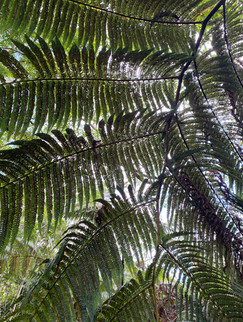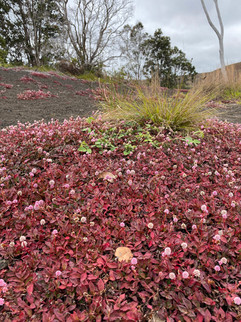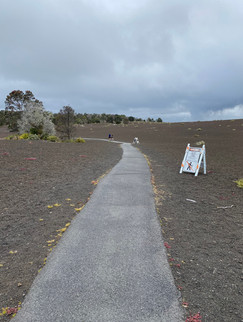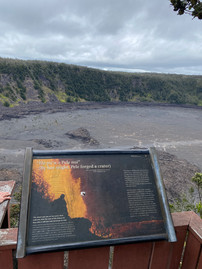Exploring the Wonders of Hawaii Volcanoes National Park
- Marie Williams
- May 16
- 11 min read

Hawai'i Volcanoes National Park stands out from all other parks in the United States. Where else can you observe an ACTIVE volcano in a national park? This extraordinary park will captivate you with the thrill of seeing rare birds, lava tubes, local flora, and, naturally, volcanoes.
Hawaii Volcanoes National Park hosts the world's most active volcanoes, Kīlauea and Mauna Loa. As of May 2025, Kīlauea is in Episode 21. The ongoing eruption at Kīlauea's Halemaʻumaʻu crater within Kaluapele (the summit caldera) started on December 23, 2024. To date, there have been 21 episodes, each interrupted by pauses in activity. You can view the eruption at the Kīlauea Overlook.
Explore Crater Rim Drive, which is an 11-mile road that borders the Kilauea Caldera in Hawai'i Volcanoes National Park, with various scenic views and hiking opportunities. Additionally, you can visit Thurston Lava Tube (Nāhuku), which once had lava flowing through it.
Additionally, stroll along a paved path through Devastation Trail, a stunningly beautiful landscape in recovery that was once blanketed by cinder from the extraordinary lava fountains of the 1959 Kīlauea Iki eruption. Observe life reemerging in this once ravaged area.

Kīlauea is both the youngest and most active volcano on Hawaiʻi Island and ranks among the most active around the world. Throughout recorded history, Kīlauea has experienced only brief pauses in activity. Over the past 1,000 years, lava flows have covered nearly 90% of its surface. It is said that the name Kīlauea means “spewing” or “much spreading.”
How To Get Here

Hawai'i Volcanoes National Park is located on the island of Hawai'i, also referred to as the Big Island.
Apart from traveling by cruise ship, flying is the sole method to reach this destination. Traveling from the mainland to Hawaii can be quite a journey. It typically takes about 5 hours to fly from California to Hawaii. Consequently, if you're located in the Midwest or on the East Coast, you'll likely need to take at least two separate flights to arrive at the Big Island.
Once on Big Island, you will arrive at either Kona International Airport (KOA) or Hilo International Airport (ITO).
Kona International Airport (KOA)
Ellison Onizuka Kona International Airport at Keahole, known as KOA, is situated on the leeward (western) side of the Big Island. It is approximately 7 miles northwest of Kailua-Kona, accessible via the Queen Kaahumanu Highway. Kona International Airport serves domestic overseas, international, interisland, commuter/air taxi, and general aviation flights.
Hilo International Airport (ITO)
Hilo International Airport is situated approximately 2 miles east of Hilo on the eastern, or windward, coast of the Big Island. The airport primarily serves domestic flights, including interisland air carrier and general aviation operations.
Numerous flights to both Hilo and Kailua-Kona start as inter-island flights from Oahu’s Daniel K. Inouye International Airport, or from other smaller airports across the islands.
We arrived at Kona International Airport, which is a pleasant and relatively small airport. The majority of the airport features open-air spaces and is easy to navigate. Across the street, a small trolley-style train is available to take you to the car rental area.

Where To Stay
We stayed at the Outrigger Kona Resort and Spa , Which is located along the west coast of Big Island. Although there are numerous accommodations on the island, I opted for the Outrigger Kona Resort due to its excellent reviews and its slightly closer proximity to the national park. The resort is just a 30-minute drive from Kona International Airport and a 2-hour drive to the national park.
I would have been content simply staying at the resort. They offered two large pools, on-site restaurants, a cafe and market, and numerous resort activities, including hula dancing and ukelele lessons.

Although we didn't attend, the Outrigger Resort also offers a Feast & Fire dinner show on-site for an extra charge.
The resort was clean and easy to navigate, but it was quite expansive. The pools were large, warm, and inviting. It was convenient to have an on-site market for purchasing food, drinks, and toiletries. Overall, I would recommend this resort for its convenient location and amenities, although the price reflects these advantages.
In addition, the Outrigger Resort is conveniently located just a five-minute walk from Keauhou Bay, which is renowned as the best place in the world for nighttime Manta Ray viewing. We decided to go on a snorkeling tour with Sea Paradise, allowing us to see our hotel while snorkeling and observing Manta Rays up close. This experience was incredible and a fantastic activity to undertake.
If you prefer not to participate in this excursion, visit the Manta Ray viewing room on the hotel's premises and enjoy watching the Manta Rays swim from the comfort of the hotel deck.
Getting To Hawaii Volcanoes National Park
We departed from our hotel early to enjoy a quick breakfast and arrive at the park by 9:00 am.
I must acknowledge Kaya's Coffee & Bakery, conveniently located on our way to the park. We paused at this charming bakery for some excellent Kona coffee and a tasty bagel sandwich. Since there aren't many dining options in the park, we saved half of our sandwich to enjoy as a snack later.
Naturally, I browsed the locally crafted art and jewelry while waiting for my matcha drink to take away.
We had allocated just one day for our visit, and I believe we were able to explore a significant portion of the park within this time frame.Nevertheless, there was still so much more to discover that one could easily spend a few days exploring this park.

While many people enjoy visiting the park at night to catch a glimpse of the red glow from the active Kilauea volcano, we didn't want to sacrifice precious sleep hours for this experience.If this interests you, there are several nearby hotels where you can stay to see the red lava at night. I do like to look at Booking.com to book my accomodations.
Reaching the national park from our hotel took approximately 2 hours and was an easy route to follow along HI-11/Hawaiʻi Belt Rd.

Right before you enter the park, you'll notice the national park sign. Pause there and snap some photos.It's always a fun memory for us.
Beyond the sign, you'll come across the entrance station. Every visitor to Hawai'i Volcanoes National Park must pay an entrance fee. However, if you possess a valid America the Beautiful—National Parks and Federal Recreational Lands Annual Pass or a Hawaiʻi Annual Tri-Park Pass, you do not need to buy a digital pass via Recreation.gov.
The park remains open 24 hours a day, 7 days a week. Nonetheless, it's advisable to visit the website for any road closures caused by volcanic eruptions.
Standard pass - $30 and good for 7 days
Annual pass - $55
Buses and vans do cost more. Check the national park website for more inofrmation on pricing.
Welcome Center
The Welcome Center is an excellent first stop when entering the park, located just 1.25 miles beyond the park entrance station. Rangers and volunteers are available daily to offer updates on current conditions, hiking details, activities, and the daily schedule of ranger-led events. For about two years during its renovation, the Welcome Center will temporarily replace the Kīlauea Visitor Center.
The Welcome Center is open 9 a.m. to 4:45 p.m. daily.
The park store offers souvenirs like t-shirts, magnets, bookmarks, and more. Portable toilets are also available in this area.
Don't forget to refill your water containers and buy bug spray if you haven't brought any. One of the enjoyable aspects of this park is the absence of animals like bears or reptiles like snakes that might pose a threat. The only bite you might experience is from a mosquito, so be prepared. Also, don't forget to bring some sunscreen!

Kīpukapuaulu Trail
We retraced our steps a little to explore the Kīpukapuaulu trail first. The trail's entrance is located just after the entrance station on the left side of the road, so we only had to deviate a few minutes from our path to reach it.

This easy loop trail, spanning 1.2 miles (1.9 km), meanders through native forestland, attracting rare birds to the area. A kīpuka is a section of land encircled by newer lava flows, resembling an “island” amid a sea of lava. This location has more native tree species per acre than any other forest in the national park, attracting native forest birds that depend on these trees.
Difficulty: Easy
Distance and hiking time: 1.2 mile (1.9km) loop, 1.0 - 1.5 hours.
Trail begins at the Kīpukapuaulu parking area.
The trail is a dirt path with mild uphill and downhill sections. Please note that dogs, horses, and bicycles are not allowed on this trail.
This is a paradise for enthusiastic birdwatchers. You will encounter numerous Honeycreepers, Japanese white-eye and various other rare birds here. Experiencing a hike while listening to the enchanting sounds of birds in paradise was truly magical.

Nāhuku (Thurston Lava Tube)

Our next destination was the Nāhuku (Thurston Lava Tube), but we chose to park at the Kīlauea Iki Overlook, which is linked to the lava tubes by a picturesque half-mile hike. However, upon reaching the lava tube, we observed that there was plenty of parking available, even on a Saturday afternoon. Therefore, if you prefer to visit the lava tube without the extra mile of walking, it’s a good idea to check the parking availability at Thurston Lava Tube first.

We parked at the Kīlauea Iki Overlook and took a moment to savor the rest of our tasty breakfast sandwich. Restrooms are also accessible at this location.

Take the trail indicated by the sign (refer to the photo above) that directs you to the Thurston Lava Tube. The round trip is 1 mile. Meander through a lush forest until you reach the parking lot for Nāhuku (Thurston Lava Tube). Cross the parking lot at the crosswalk and enter the trail to reach the lava tube.

You will descend through a lush rainforest before entering a 500-year-old lava tube where a river of 2000-degree Fahrenheit lava once flowed. Its Hawaiian name, Nāhuku, translates to "the protuberances," likely referring to the lava drippings that once adorned the ceiling. Unfortunately, these drippings vanished due to souvenir collectors after the tube's discovery in 1913. Entire ecosystems of creatures inhabit these delicate environments found throughout the Island of Hawaiʻi. Please show respect and avoid touching the walls or any hanging roots.
Exploring the lava tube takes just 5-10 minutes. Illuminated with striking red lights, this tube, once filled with lava, offers an enjoyable exploration experience. At the end, you'll climb a flight of stairs that returns you to your starting point. In this area, there's also a nice and new restroom available.

Trailheads: Nāhuku (Thurston Lava Tube) parking area and Kīlauea Iki Overlook. Parking at Nāhuku (Thurston Lava Tube) is very limited.
Difficulty: Moderate
Distance: 1.5 mi (2.4 km) round-trip walk from Kīlauea Iki Overlook. 6.0 mi (9.7 km) round-trip from Devastation Trailhead (including the Kīlauea Iki loop), with an extra 1.0 mi (1.6 km) from Puʻupuaʻi
The lava tube is illuminated from 8 a.m. to 8 p.m. Bring a flashlight outside these hours.
Restrooms near the lava tube are available from 9 a.m. to 5 p.m.
Return to Kīlauea Iki Overlook the same way you arrived. There are also other trailmarkers which lead to other areas of the park to explore. One of which is the popular Kīlauea Iki Trail, and is considered a moderate/challenging hike. Here you can make your way down through a rainforest to reach the hardened lava lake on the floor of Kīlauea Iki crater. Look into the vent that, during the 1959 eruption, spewed lava up to 1900 feet high, situated beneath the Puʻupua‘i cinder cone.
Unfortunately, this hike might take 2-3 hours, and given that it was a difficult trek, we chose to skip it.
Wahinekapu (Steaming Bluff)

At Wahinekapu (Steaming Bluff), just a brief stroll from the Steam Vents parking area, you can experience the volcano's breath as hot water vapor rises from the ground. This remarkable occurrence happens when groundwater trickles down to rocks heated by magma deep below the surface. The extreme heat of the rocks turns the water into steam, which then rises back to the surface.
From here you have the option to hike the Crater Rim Trail, which crosses the summit caldera of Kīlauea, or take the 12 minute stroll to Haʻakulamanu (Sulphur Banks).
Originally, the Crater Rim Trail encircled the whole of Kīlauea Caldera, but due to the current eruption cycle, much of it is now inaccessible because of hazardous conditions. This hike covers a section of the Crater Rim Trail from the Hawai'i Volcanoes National Park Visitor Center to the Jaggar Museum along the northern rim of Kīlauea Caldera. The views along the path are spectacular.
You can hike as far as you like. The location offers stunning views of the Kīlauea caldera.
The trail is made of gravel and is easy to walk on. Additionally, you can observe numerous beautiful plants along the route.
Keanakako'i Overlook

Keanakākoʻi, meaning "cave of the adzes," likely formed in the 1400s during the major summit collapses of Kīlauea. Until 1877, Hawaiian kahuna kākoʻi (carving experts) sought the crater's rare basaltic rock for crafting koʻi, or adze heads. Attached to a sturdy ʻau koʻi (wooden handle), this valuable tool was used to carve essential items like canoes and houses. However, the renowned adze quarry was covered by lava, first in 1877 and again during the fissure eruption in July 1974. Now, the crater is 115 feet deep.
The park closed sections of Crater Rim Drive after Halemaʻumaʻu started erupting in March 2008. The road became partially damage during the summit collapses of 2018 and was never repaired. However, this part of Old Crater Rim Drive is now open to pedestrians and cyclists up to just beyond Keanakākoʻi.
To hike the portion of Old Crater Rim Drive to Keanakākoʻi Crater Overlook:
Difficulty: Easy (paved road)
Distance and hiking time: 1 mile (1.6 km) one way, 2 miles (3.2 km) roundtrip. Estimated time is 1 - 1 1/2 hours.
Trailhead: Park at the Devastation Trailhead parking lot. Trail begins near the parking lot exit on Crater Rim Drive near the restrooms.

At the overlook, we observed a white bird. Upon closer inspection with our binoculars, we identified it as the White-tailed tropicbird, or koaʻe kea. These birds are commonly seen soaring above Kīlauea volcano, especially near the Kīlauea caldera and other craters. Known for their graceful flight and long, white tails, these seabirds nest on the walls of craters, often miles from the ocean, and are frequently observed flying around the lava lake within the crater.

Devastation Trail

From the same parking lot enter the Devastation trailhead. Stroll along a paved path through a remarkably beautiful landscape in recovery, which was once blanketed by cinder from the awe-inspiring lava fountains of the 1959 Kīlauea Iki eruption. Here you can see life reemerging in this once devastated area, particularly the beautiful Pinkhead Smartweed, flourishing throughout.
Puʻupuaʻi, which translates to "gushing hill" in Hawaiian, is a massive cinder cone created by the impressive 1,900-foot lava fountains during the 1959 eruption of Kīlauea Iki. As the lava from these fountains cooled while airborne, it descended as cinders and accumulated into the substantial mound present today. From this viewpoint, you can look into the Kīlauea Iki crater and start the Devastation Trail, or proceed to hike to Byron Ledge (Uēaloha), Kīlauea Iki, and Nāhuku (Thurston Lava Tube).
Difficulty: Easy - accessible for wheelchairs and strollers. Some parts of this paved trail have slopes exceeding eight percent (8%).
Distance and hiking time: 1 mile (1.6km) round trip, approximately 1.0 hour.
Trail begins: Either at the Pu'upua'i parking lot or the Devastation Trail parking lot, both off of Crater Rim Drive.

Puʻupuaʻi Viewpoint
Leaving Hawaii Volcanoes National Park is a bittersweet experience, as memories of breathtaking landscapes, unique geological formations, and rich cultural history linger. The park highlights the impact of volcanoes on landscapes, ecosystems, and communities, showcasing nature's resilience.
Departing the park is not just leaving a beautiful place but carrying an enriching experience. This park will definitely leave a lasting impression.
Where To Eat in Kona
Kona Brewing Company
We returned to Kona in less than 2 hours to have dinner at Kona Brewing Company.
After a long day of outdoor adventures, nothing beats enjoying pizza and beer. Kona Brewing Co. certainly fit the bill. They had delicious appetizers, delicious pizza (we enjoyed the Hawaiian lu’au piza with Fire Rock Pale Ale BBQ sauce, Mozzarella, Goat Cheese, Kalua Pork, Sweet Onion, and a Jalapeño Pineapple Salsa)
Pine Tree Cafe
Searching for delicious island traditional food? Visit Pine Tree Cafe near the airport for tasty plate lunches, spam musubi, or a loco moco.
Broke Da Mouth Grindz
To enjoy some incredible garlic furikake chicken and garlic shrimp, make sure to visit Broke Da Mouth Grindz near Kailua-Kona. This spot offers some fantastic grindz (Hawaiian Pidgin for amazing food). I was particularly impressed by the egg/macaroni salad and the rice, which was soaked in the garlic butter from the shrimp. Check out their hours on their website. They close in the afternoon between lunch and dinner and are closed on Sundays. If you have room get some of their ice cream pie.
Following our visit to Big Island and the beautiful Hawaii Volcanoes National Park, we took a brief 40-minute flight with Hawaiian Airlines to Maui to explore Haleakalā National Park.






































































































































































Comments